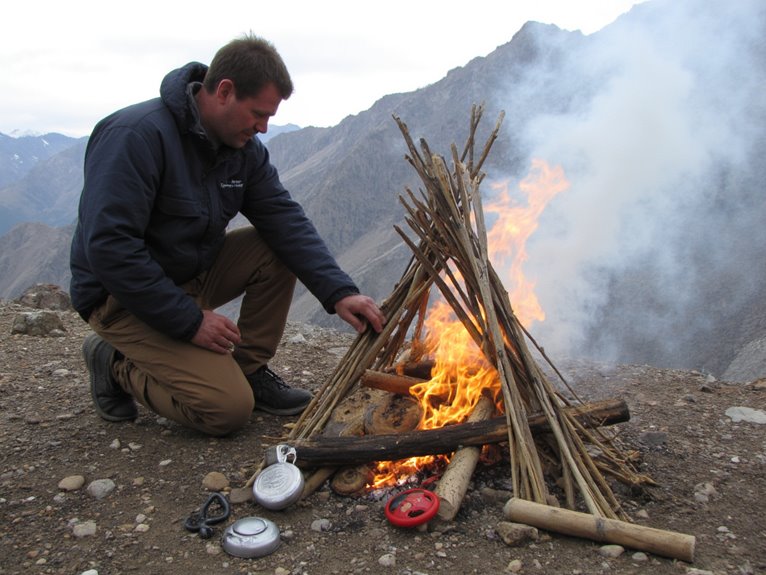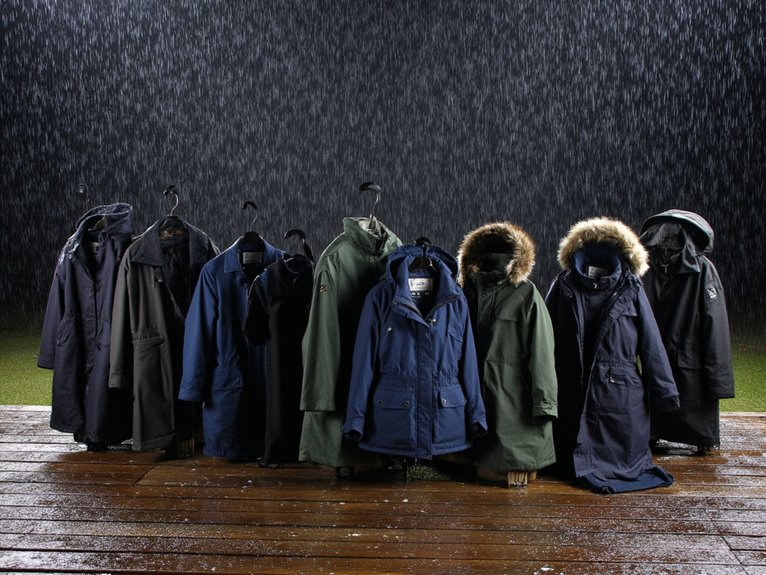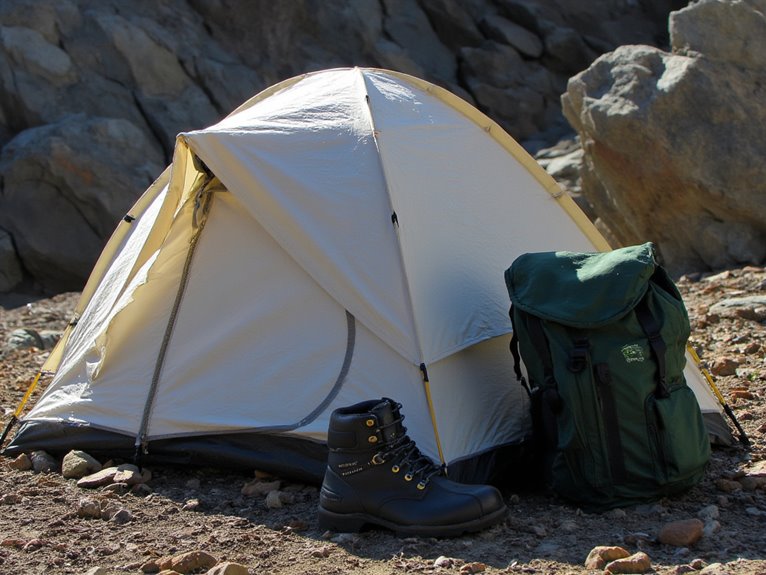Building Signal Fires: Getting Rescued When Your PLB Fails
When your PLB fails, you’ll need three signal fires arranged in an equilateral triangle spaced 30-100 feet apart on high ground with clear sightlines. Use green vegetation for dense white smoke against forest backgrounds, or create black smoke for snow-covered terrain. Build pyramid-structure fires and maintain them continuously with dry materials ready. Position yourself upwind from expected rescue routes and combine smoke signals with mirror flashes extending up to 160 kilometers for maximum effectiveness across multiple communication channels.
We are supported by our audience. When you purchase through links on our site, we may earn an affiliate commission, at no extra cost for you. Learn more. Last update on 8th January 2026 / Images from Amazon Product Advertising API.
Notable Insights
- Select high ground positions with 360-degree visibility, avoiding valleys and obstructions for maximum signal range effectiveness.
- Build three fires in equilateral triangle formation spaced 30-100 feet apart to create internationally recognized distress signal.
- Use green vegetation for white smoke in forests, wet materials for black smoke in snow/desert environments.
- Combine mirror flashes with three-burst light patterns and whistle SOS signals for multi-sensory rescue communication.
- Create backup ground signals using rock triangles and directional arrows when fire materials are unavailable.
Selecting the Optimal Location for Maximum Visibility
Where you position your signal fire determines whether rescuers will spot you or pass by unaware of your location. Proper terrain assessment begins with identifying elevated positions that provide maximum visibility. High ground increases your signal’s effective range by 5-10 miles compared to valley positions.
Conduct thorough visibility factors analysis before lighting your fire. Clear sightlines extend 360 degrees without tree canopies, rock formations, or hills blocking the signal. Natural clearings, ridgelines, and riverbanks offer ideal positioning. Wind direction affects smoke dispersal patterns-position yourself upwind from expected rescue approach routes.
In dense forests, create artificial clearings if necessary. The triangular configuration requires three fires spaced 100 paces apart on level terrain. Avoid slopes exceeding 15 degrees where smoke disperses unpredictably.
Consider environmental conditions when establishing your signal fire location, as quick-dry technology performs well in humid conditions similar to how proper moisture management affects fire sustainment in varying weather.
Your location becomes your lifeline.
Constructing and Managing Your Signal Fire

Once you’ve secured your ideal location, proper fire construction becomes the critical factor separating successful rescue from prolonged survival situations.
Your material selection directly impacts signal effectiveness. Green vegetation produces dense white smoke visible for miles during daylight hours. Wet wood creates consistent smoke output. Pitch-bearing pine creates thick, dark smoke that contrasts against sky backgrounds.
Build your fire in a pyramid structure with tinder at the base, kindling in the middle, and fuel wood on top. This configuration maximizes both flame height and smoke production.
Fire maintenance requires continuous attention. Keep dry materials ready for quick ignition when aircraft approach. Monitor wind direction constantly to position smoke for maximum visibility while preventing wildfire spread.
Creating the International Distress Triangle Configuration
The international distress triangle configuration transforms three separate signal fires into a universally recognized emergency beacon that dramatically increases your rescue probability. Position your fires at equal distances from each other, creating an equilateral triangle visible from aircraft and ground rescue teams.
Select triangle materials that maximize contrast against your environment. Use rocks, logs, or cleared ground patches as foundation points. Each fire should be spaced 30-100 feet apart depending on terrain visibility and available fuel supplies.
These spacing techniques guarantee aerial recognition while maintaining manageable fire control distances.
Build each fire large enough to produce substantial smoke during daylight hours. Maintain consistent fuel loads across all three points.
The geometric pattern signals intentional human activity rather than natural occurrence, triggering immediate rescue response protocols when spotted by search teams. Emergency blankets with reflective surfaces can be positioned near each fire point to enhance visibility and assist rescue teams in locating your position from greater distances.
Enhancing Signal Effectiveness With Smoke and Light Techniques
Although your triangle configuration provides the foundational distress pattern, maximizing smoke and light signals transforms your rescue beacon from basic visibility into an unmistakable emergency broadcast.
Smoke color determines detection success across terrain types. White smoke contrasts effectively against forested backgrounds, while black smoke cuts through snowy or desert environments. Add damp vegetation for thick white output, or introduce oil-soaked materials for dense black contrast.
Light signals extend your signaling range to 160 kilometers using mirrors or polished metal. Light duration follows the three-flash distress pattern, matching your smoke bursts for coordinated visibility.
Mirror signals can reach targets up to 160 kilometers away when following the three-flash distress pattern for maximum rescue visibility.
- Use green vegetation over dry base fires for controlled smoke bursts
- Position mirrors facing sun with reflected light aimed at target areas
- Deploy light signals at dawn when smoke visibility decreases
- Combine whistle blasts with visual signals for multi-sensory detection
Reliable ignition becomes critical when conditions turn adverse, making waterproof lighters essential backup tools when matches fail during wet weather emergencies.
Backup Signaling Methods When Fires Aren’t Enough
When fire materials become unavailable or weather conditions prevent reliable ignition, you’ll need alternative signaling methods that don’t depend on combustion.
Audible signals provide consistent backup options regardless of visibility conditions. Whistles produce sharp sounds audible over long distances using standard SOS patterns-three short, three long, three short blasts.
Stone clapping or knife handle tapping creates rhythmic sequences distinguishable from natural sounds. Hollow logs amplify sound propagation in echo-prone areas.
Visual signals work effectively during daylight hours. Construct triangular rock formations at least 10 feet long for aerial visibility. Use contrasting materials-dark rocks on light ground or vice versa.
Signal mirrors redirect sunlight several miles to aircraft. Even improvised reflectors like CDs substitute for proper mirrors. Ground arrows pointing toward your travel direction help searchers track movement patterns.
Frequently Asked Questions
How Long Can a Signal Fire Realistically Burn With Limited Fuel Resources?
Your signal fire duration depends heavily on fuel efficiency and available materials.
Dense hardwoods like oak burn 2-4 hours per armload, while softwoods last only 1-2 hours.
You’ll get maximum burn time by using finger-thick kindling as your base and adding progressively larger pieces.
Green vegetation creates smoke but reduces burn duration by 30-40%.
Expect 4-6 hours from carefully managed fuel supplies in survival situations.
What Should I Do if My Signal Fire Accidentally Starts a Wildfire?
You must immediately implement fire control measures.
Douse flames with water, dirt, or sand.
Remove flammable materials within a 10-foot radius to create firebreaks.
Focus suppression efforts on the fire’s leading edge where it spreads fastest.
Follow emergency protocols: signal for help using whistles or mirrors, then evacuate to safety if containment fails.
Report the wildfire location to authorities immediately upon rescue.
How Far Away Can Aircraft Typically Spot a Signal Fire During Daylight?
Aircraft can typically spot signal fires from 10-20 miles away during ideal daytime conditions.
Distance visibility depends on fire size, smoke production, and atmospheric clarity.
Commercial aircraft at cruising altitude detect large signal fires from 30+ miles, while search aircraft flying lower spot smaller fires within 5-10 miles.
Clear weather and minimal haze maximize detection range, but fog or atmospheric interference can reduce visibility to just 1-2 miles.
Is It Safe to Leave a Signal Fire Unattended While Sleeping?
You should never leave a signal fire unattended while sleeping.
Signal fire safety requires constant supervision because unattended fires can rapidly escape control, becoming dangerous wildfires that endanger both you and rescuers.
Sleeping precautions are critical-even small breezes can spread embers significant distances while you’re unconscious.
Always extinguish your signal fire completely before resting, then relight it when you’re awake and alert.
What Legal Consequences Might I Face for Starting Signal Fires on Public Land?
You’ll face serious legal repercussions for unauthorized signal fires on public land.
Reckless burning constitutes a felony under statutes like California Penal Code § 452, carrying up to 9 years imprisonment. You need permits from forestry agencies before starting any fire.
Even emergency situations don’t guarantee legal immunity. Civil liability includes firefighting costs, property damage, and ecological restoration expenses.
Criminal charges apply regardless of intent if your fire causes harm or spreads.
On a final note
Signal fires remain your most reliable backup when electronic devices fail. You’ve learned proper site selection, construction methods, and the distress triangle pattern. Combine these techniques with smoke enhancement and supplementary signaling methods for maximum effectiveness. Practice these skills before you need them. Your preparation determines rescue success when technology fails. Remember: three of anything signals distress. Stay visible, stay safe, and keep multiple signaling options ready at all times.



